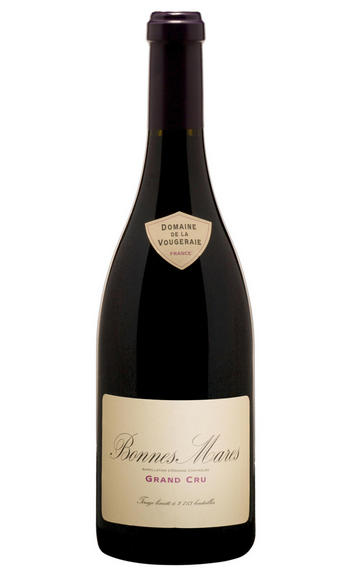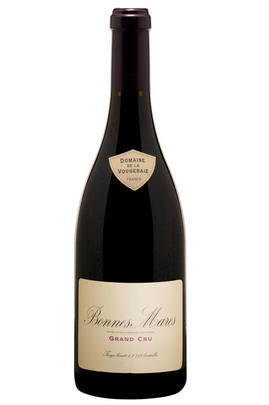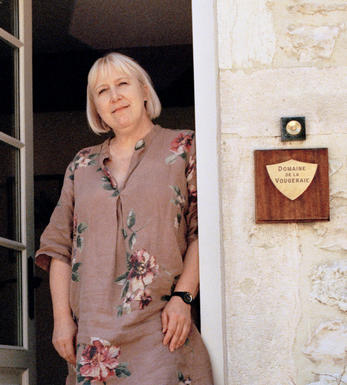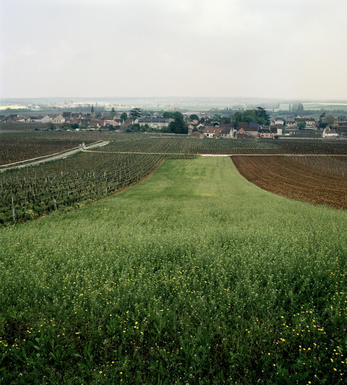
2013 Bonnes Mares, Grand Cru, Domaine de la Vougeraie, Burgundy

Critics reviews
From vines by the Morey border, 50% of which were planted in 1902; 80% whole clusters.
A background whisper of wood spice adds breadth to the aromas of exceptionally fresh and earthy red berries, rose petal, Asian-style tea and a hint of underbrush. There is excellent richness to the muscular yet relatively refined, intense and tautly muscular big-bodied flavours that are shaped by a firm but not really austere core of ripe tannins on the impressively well-balanced and highly persistent finale. Good stuff that should amply repay extended cellaring.
Drink from 2025 onward
Allen Meadows, Burghound.com (January 2015)
The 2013 Bonnes Mares Grand Cru is raised in the same fashion as the Charmes-Chambertin: 80% whole cluster with 50% new oak. It has a very suave bouquet with black cherries and raspberry notes underlain by cold wet limestone scents – in a way, a “well-behaved” Bonnes-Mares. The palate is medium-bodied with firm tannins, a little aloof at the moment, and without the exuberance of ambition of the Charmes-Chambertin. It will benefit from 5 or 6 years of ageing in bottle.
Drink 2020 - 2030
Neil Martin, Wine Advocate (December 2014)
Good medium red. Very ripe, soil-driven aromas of mocha, game, tobacco and cocoa powder. Strong red fruit and spice flavours emerge on the wonderfully dense, sweet palate, with an element of saline minerality providing another dimension. The wine's superb energy gives the highly concentrated fruit a bulletproof quality. Impressively dense and large-scaled for the year, finishing with substantial ripe tannins and excellent balance and length. Vincent's wines have been distinctly fresher and firmer since 2010 as he's now picking a bit earlier to avoid surmaturité.
Winemaker Pierre Vincent finds the 2014s riper and fruitier than the 2013s, but noted that the '13s have very good phenolic maturity considering the fact that potential alcohol levels in the grapes were typically around 11.7% (he chaptalized an average of one degree). Vincent started harvesting on September 29, thus avoiding the most damaging October rains. I was more than satisfied with the 2013s I tasted in November.
Drink 2024 - 2036
Stephen Tanzer, Vinous.com (March 2016)
About this WINE

Domaine de la Vougeraie
Domaine de la Vougeraie is part of our Spotlight on sustainability series. You can view the full range here.
Domaine de la Vougeraie, based in Premeaux just south of Nuits St Georges, was created in 1999 when Jean-Claude Boisset of the Boisset group decided to group together all the vineyard holdings of his various negociant companies acquired over the years. The name comes from the significant holdings – and indeed Jean-Claude Boisset’s home – in the village of Vougeot. The winery is located however in the old Claudine Deschamps (Madame Jean-Claude Boisset) cellars in Prémeaux. The domaine was put together from the various vineyard holdings which had accrued through the Boisset acquisitions of Burgundian houses over the years. Pascal Marchand was put in charge in 1999, with Bernard Zito in the vineyards, which were farmed biodynamically. Pascal produced powerful wines, fairly heavily extracted in his early vintages but clearly was subsequently moving to a softer approach by 2004.
With nearly 40 hectares of vineyard and over 30 different appellations, including six grand crus (Musigny, Bonnes Mares, Clos Vougeot, Charmes Chambertin, Mazoyères, Corton Clos du Roi and Corton Charlemagne), this is one of Burgundy’s leading domaines.
No expense has been spared in production terms. The premier and grand cru vineyards are all farmed biodynamically with carefully limited yields. The cellar has been equipped with a battery of new or renovated wooden fermentation vats, a state of the art sorting table and a new model of the old fashioned vertical press which is thought to be the best option for red wines. The wines were made by Pascal Marchand of Comte Armand in Pommard, from 1999 to 2005 and subsequently by Pierre Vincent who has maintained the more delicate approach. The grapes are sorted on one of the longest tables de tri I have seen, before being given a cool pre-maceration. During fermentation Pierre punches down only once a day, much less than Pascal used to. The temperature is maintained at 26º-28ºC/79-81ºF after fermentation to polymerise the tannins and fix the colour. The Musigny is destemmed by hand. Starting in 2008 he has begun to experiment with some whole bunch fermentation, though only for a proportion of a given cuvée.

Morey-Saint-Denis
Morey is sometimes ignored between its two famous neighbours, Chambolle-Musigny and Gevrey-Chambertin, but its wines are of equal class, combining elegance and structure. Morey-St Denis, being that little bit less famous, can often provide excellent value.
The four main Grand Cru vineyards continue in a line from those of Gevrey-Chambertin, with Clos St Denis and Clos de la Roche the most widely available. Clos des Lambrays (almost) and Clos de Tart (entirely) are monopolies of the domains which bear the same names.
Domaine Dujac and Domaine Ponsot also make rare white wines in Morey-St Denis.
- 64 hectares of village Morey-St Denis
- 33 hectares of Premier Cru vineyards (20 in all). Best vineyards include Les Charmes, Les Millandes, Clos de la Bussière, Les Monts Luisants
- 40 hectares of Grand Cru vineyard. Clos de Tart, Clos des Lambrays, Clos de la Roche, Clos St Denis and a tiny part of Bonnes Mares
- Recommended Producers: Dujac, Ponsot, Clos de Tart, Domaine des Lambrays

Pinot Noir
Pinot Noir is probably the most frustrating, and at times infuriating, wine grape in the world. However when it is successful, it can produce some of the most sublime wines known to man. This thin-skinned grape which grows in small, tight bunches performs well on well-drained, deepish limestone based subsoils as are found on Burgundy's Côte d'Or.
Pinot Noir is more susceptible than other varieties to over cropping - concentration and varietal character disappear rapidly if yields are excessive and yields as little as 25hl/ha are the norm for some climats of the Côte d`Or.
Because of the thinness of the skins, Pinot Noir wines are lighter in colour, body and tannins. However the best wines have grip, complexity and an intensity of fruit seldom found in wine from other grapes. Young Pinot Noir can smell almost sweet, redolent with freshly crushed raspberries, cherries and redcurrants. When mature, the best wines develop a sensuous, silky mouth feel with the fruit flavours deepening and gamey "sous-bois" nuances emerging.
The best examples are still found in Burgundy, although Pinot Noir`s key role in Champagne should not be forgotten. It is grown throughout the world with notable success in the Carneros and Russian River Valley districts of California, and the Martinborough and Central Otago regions of New Zealand.


Buying options
Add to wishlist
Description
Glowing purple colour with very lovely elegant pure fruit, this has a dancing brilliance which builds magically behind with a wave of different deep red and some black fruit. Crystalline and exceptionally persistent. A wonderful wine.
The harvest began with whites on 26th September, before the rain, then the reds were brought in during less good weather, with sorting necessary. The stems were ripe enough to allow for whole bunch vinification, and Pierre has chosen the soft pedal in 2013: not much punching down, more an infusion approach, less new wood and perhaps a shorter time in barrel. Pierre can see some elements of 2008 but with more weight, more flattering wines overall.
Berry Bros. & Rudd
wine at a glance
Delivery and quality guarantee